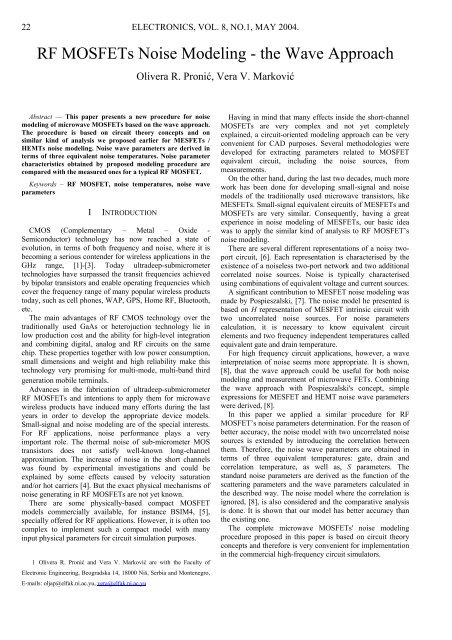elektronika electronics - Electronics Journal - Elektrotehnicki fakultet
elektronika electronics - Electronics Journal - Elektrotehnicki fakultet
elektronika electronics - Electronics Journal - Elektrotehnicki fakultet
Create successful ePaper yourself
Turn your PDF publications into a flip-book with our unique Google optimized e-Paper software.
22<br />
ELECTRONICS, VOL. 8, NO.1, MAY 2004.<br />
RF MOSFETs Noise Modeling - the Wave Approach<br />
Abstract — This paper presents a new procedure for noise<br />
modeling of microwave MOSFETs based on the wave approach.<br />
The procedure is based on circuit theory concepts and on<br />
similar kind of analysis we proposed earlier for MESFETs /<br />
HEMTs noise modeling. Noise wave parameters are derived in<br />
terms of three equivalent noise temperatures. Noise parameter<br />
characteristics obtained by proposed modeling procedure are<br />
compared with the measured ones for a typical RF MOSFET.<br />
Keywords – RF MOSFET, noise temperatures, noise wave<br />
parameters<br />
I INTRODUCTION<br />
CMOS (Complementary – Metal – Oxide -<br />
Semiconductor) technology has now reached a state of<br />
evolution, in terms of both frequency and noise, where it is<br />
becoming a serious contender for wireless applications in the<br />
GHz range, [1]-[3]. Today ultradeep-submicrometer<br />
technologies have surpassed the transit frequencies achieved<br />
by bipolar transistors and enable operating frequencies which<br />
cover the frequency range of many popular wireless products<br />
today, such as cell phones, WAP, GPS, Home RF, Bluetooth,<br />
etc.<br />
The main advantages of RF CMOS technology over the<br />
traditionally used GaAs or heterojuction technology lie in<br />
low production cost and the ability for high-level integration<br />
and combining digital, analog and RF circuits on the same<br />
chip. These properties together with low power consumption,<br />
small dimensions and weight and high reliability make this<br />
technology very promising for multi-mode, multi-band third<br />
generation mobile terminals.<br />
Advances in the fabrication of ultradeep-submicrometer<br />
RF MOSFETs and intentions to apply them for microwave<br />
wireless products have induced many efforts during the last<br />
years in order to develop the appropriate device models.<br />
Small-signal and noise modeling are of the special interests.<br />
For RF applications, noise performance plays a very<br />
important role. The thermal noise of sub-micrometer MOS<br />
transistors does not satisfy well-known long-channel<br />
approximation. The increase of noise in the short channels<br />
was found by experimental investigations and could be<br />
explained by some effects caused by velocity saturation<br />
and/or hot carriers [4]. But the exact physical mechanisms of<br />
noise generating in RF MOSFETs are not yet known.<br />
There are some physically-based compact MOSFET<br />
models commercially available, for instance BSIM4, [5],<br />
specially offered for RF applications. However, it is often too<br />
complex to implement such a compact model with many<br />
input physical parameters for circuit simulation purposes.<br />
1 Olivera R. Pronić and Vera V. Marković are with the Faculty of<br />
Electronic Engineering, Beogradska 14, 18000 Niš, Serbia and Montenegro,<br />
E-mails: oljap@elfak.ni.ac.yu, vera@elfak.ni.ac.yu<br />
Olivera R. Pronić, Vera V. Marković<br />
Having in mind that many effects inside the short-channel<br />
MOSFETs are very complex and not yet completely<br />
explained, a circuit-oriented modeling approach can be very<br />
convenient for CAD purposes. Several methodologies were<br />
developed for extracting parameters related to MOSFET<br />
equivalent circuit, including the noise sources, from<br />
measurements.<br />
On the other hand, during the last two decades, much more<br />
work has been done for developing small-signal and noise<br />
models of the traditionally used microwave transistors, like<br />
MESFETs. Small-signal equivalent circuits of MESFETs and<br />
MOSFETs are very similar. Consequently, having a great<br />
experience in noise modeling of MESFETs, our basic idea<br />
was to apply the similar kind of analysis to RF MOSFET’s<br />
noise modeling.<br />
There are several different representations of a noisy twoport<br />
circuit, [6]. Each representation is characterised by the<br />
existence of a noiseless two-port network and two additional<br />
correlated noise sources. Noise is typically characterised<br />
using combinations of equivalent voltage and current sources.<br />
A significant contribution to MESFET noise modeling was<br />
made by Pospieszalski, [7]. The noise model he presented is<br />
based on H representation of MESFET intrinsic circuit with<br />
two uncorrelated noise sources. For noise parameters<br />
calculation, it is necessary to know equivalent circuit<br />
elements and two frequency independent temperatures called<br />
equivalent gate and drain temperature.<br />
For high frequency circuit applications, however, a wave<br />
interpretation of noise seems more appropriate. It is shown,<br />
[8], that the wave approach could be useful for both noise<br />
modeling and measurement of microwave FETs. Combining<br />
the wave approach with Pospieszalski's concept, simple<br />
expressions for MESFET and HEMT noise wave parameters<br />
were derived, [8].<br />
In this paper we applied a similar procedure for RF<br />
MOSFET’s noise parameters determination. For the reason of<br />
better accuracy, the noise model with two uncorrelated noise<br />
sources is extended by introducing the correlation between<br />
them. Therefore, the noise wave parameters are obtained in<br />
terms of three equivalent temperatures: gate, drain and<br />
correlation temperature, as well as, S parameters. The<br />
standard noise parameters are derived as the function of the<br />
scattering parameters and the wave parameters calculated in<br />
the described way. The noise model where the correlation is<br />
ignored, [8], is also considered and the comparative analysis<br />
is done. It is shown that our model has better accuracy than<br />
the existing one.<br />
The complete microwave MOSFETs' noise modeling<br />
procedure proposed in this paper is based on circuit theory<br />
concepts and therefore is very convenient for implementation<br />
in the commercial high-frequency circuit simulators.


